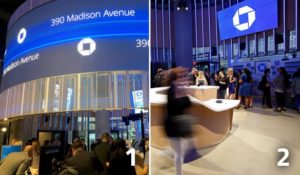2019: Year Half Over and Glass Half Full
- Branch Transformation
- Consulting
Categories:
Let’s look back on the first half of 2019, and then we can look ahead.
With 2019 now half over, we thought it might be worthwhile to revisit The Financial Brand’s article from the beginning of the year entitled, “Top Branch Trends for Banks and Credit Unions in 2019” and see if the commentary outlined in the article is still relevant. How is Branch Transformation taking hold at the mid-point of the year? Has the commentary held true? What does the (near) future look like?
Branch Closures

Our newsfeeds are still dominated with the announcements of branch closures. This may spell doom and gloom for an industry continuously accused of not modernizing fast enough for the evolving consumer sentiment, but the “death of the bank branch” is not really the story here. Under the catchy, clickbait-oriented closure headlines, the real story unfolds, telling of consolidation as a result of mergers and acquisitions and/or due to branch relocations. In fact, just under the branch closure articles may very well be a companion article talking about branch expansion.
Branch Expansion

The big banks (large national brands and dominant regional players) have announced aggressive expansion plans at the onset of the year, and those announcements haven’t died down at the year’s mid-point.
On the coattails of Chase announcing aggressive plans to expand into Philadelphia, the Financial Institution announced this Spring to open nearly 100 new branches across 9 major metro areas.
And now, Chase has just announced their new New York City Flagship Branch, meant to be the epitome of how they intend to do brick and mortar banking from here forward.
Along those lines, community banks and credit unions continue to look towards aggressive expansion plans, despite the shadow of digital banking, the allure of digital-only banking and the fear instilled in all of us when doom-and-gloom articles speak of a possible recession, etc.
In fact, here at LEVEL5, our Consulting and Real Estate divisions have never been busier. John Hyche, an industry expert often quoted in The Financial Branch article, has seen the expansion trends materializing and his book of business has never been more full. As cited in the article, one of the key drivers in community bank and credit union expansion is the evolving shift in Demography.
Demography Shifts

One of the main reasons we’re talking about expansion plans with our clients is due to the shifting geographies and needs of banking customers. Since we are continually seeking to deliver on the financial needs of the customers/members, we know that location is key and opening a new branch on the wrong street corner is a costly mistake.
It’s not even really about where things have migrated recently or currently. The proper approach to location selection is rooted in the right data approach to understand the need and identify not what’s relevant now, but what will be relevant tomorrow and in three years.
As stated in the Financial Brand article, LEVEL5‘s own John Hyche states, “Branches will continue to follow shifts in demography as new areas develop. These moves reaffirm the popularity and value of physical channels in establishing brand recognition and gaining market share.”
Branch Transformation
The final piece in this overall equation is to not turn a blind eye to trends, but to equally not rush into them haphazardly. The burden of the right digital approach is a heavy one for us all to bare, but purchase and implementation decisions shouldn’t live in a box. The right mix of Digital Signage, Full/Assisted Self Service, Kiosks, Tablets, etc. need to be deployed based on the right strategy and how they will ultimately help enhance the overall customer experience based on the way you do it.
If the year is continuing to take shape and you’re interested in learning more about branch expansion, branch transformation and the right approach, Contact Us today to get the conversation started.
7 Deadly Sins of a Bad Branch Strategy – Part 2
- Branch Transformation
- Retail
Categories:
Here we are again, naturally. The thrilling conclusion of the final 3 sins (Part 1 is Here). If this was a bad Jaws movie sequel, we’d call this part, “The Revenge,” but we’ll keep it hip and relevant and call this one, “End Game.”
So without further ado, here are the final 3 sins we’re all guilty of in some form:
5. OMNI-CHANNEL

SIN: For being too heavily weighted in one customer touch point.
It may sound like a fancy word, but omni-channel is really just the idea of ALL customer touch points not only existing, but existing harmoniously and purposefully with one another. What is born online, may very well terminate in a branch and vice versa. The right branch strategy will take the omni-channel elements into account, have equal weight at the table and understand how they all work together. The epitaph of brick and mortar has yet to be written. After all, 90% of sales still occur at a traditional store across general retail.
6. PEOPLE

SIN: For deploying poorly trained and disengaged employees.
Have you ever been to a restaurant where the food is “fine” but the service is great? You probably keep going back. Conversely, you’ve probably been to a restaurant where the food was really good, but the service lacked – and you probably haven’t been back. Why would your branch be any different? Before we even get to whether your staff has been properly and continually trained, were they even part of the original branch transformation strategy? Taking a step prior in this regard can really go a long way. Your great branch strategy and amazing design will all be for naught when your customers walk into a branch where the staff are disengaged, feel disassociated from the branch, feel that the “new” way of doing things is not their thing, more less, even understand why the technology is there in the first place. Train them well, but make them feel germane to the mission and you will have evangelists delivering amazing customer service.
7. EXPERIENCE

SIN: For not developing and delivering on a cohesive strategy and executing flawlessly to delight your customers.
When you take the right approach and blend of the six elements above, mix them together with purpose and execution, you have great customer experience. But don’t be confused here. “Customer Service” is NOT “Customer Experience.” A successfully executed transaction may not necessarily have a customer walking out the door, feeling delighted and ready to tell their friends and family it’s time to make the switch. Think big picture here. There’s more than completing the transactional circle of life from hello to goodbye. Remove barriers. Be intuitive. Enable a great flow through design, in the right part of town, with the right sized branch. Have technology enable, not scare. Have your people embody your mission and values, deliver on the promise and make every single customer who walks in want to come back, regardless of the online conveniences of some transactions. That’s a great experience.
For the sins above we have committed, there is not reason to dwell in the past.
Let’s do something about it. If you’re guilty, there’s no judgement here. All we ask is that you begin purging these sins, and that may very well start by you contacting the experts at LEVEL5.
7 Deadly Sins of a Bad Branch Strategy
- Branch Transformation
- Retail
Categories:
When discussing your own branch network and the exciting prospect of a remodel or ground-up project, you often look at your competitors, other institutions for best-in-class branch designs and even brick and mortar sites outside of a branch altogether (Apple anyone?).
While we often talk about what we like and the elements that we may want to emulate in our own project, there is the other side of the story – the “not so goods” and the “what were they thinking” elements.
And so, with that, come on a journey with us down the dark alleyways that are the 7 Deadly Sins of a Bad Branch Strategy.
1. LOCATION

SIN: For not using data to inform location decisions.
Yes, the saying still holds: Location, Location, Location. But it’s never as simple as just being in the heart of town, on the main thoroughfare or at the right ingress/egress points during rush hour. Knowing your town and your neighborhood helps, but the naked eye and good intuition do not have the luxury of data, particularly the kind of data that is forward thinking and aims to future-proof strategic decisions. The right combination of Consulting Services, which will run the right queries with the right combination of data, will yield results for tomorrow, not just today. Furthermore, the right Real Estate partner goes beyond identifying the vacant building or lot – the right Real Estate partner can find the ideal property that may not even be on the market. They know property valuations and have the experience to negotiate – getting you the right price per square foot.
2. FOOTPRINT

SIN: For choosing a branch size that is too big.
Gone are the days of 5,000+ square foot branches. With many transactions now happening outside of the branch, oversized branches aren’t necessary. This is not like tennis or golf, where an oversized head increases your sweet-spot. Oversized branches, especially for the amount of transactions occurring, are not sweet. In fact, they just feel wrong. Empty space is sinful. And worse yet, filling it in with an extra Self-Service machine to gather dust or filling it with something else unnecessary altogether is a good strategy gone wrong. Downsizing new branches or reworking the footprint for a remodel is the right approach. Make the branch feel welcoming and purposeful. Not cavernous and empty.
3. DESIGN

SIN: For choosing a design not born from strategy.
This is not about pretty or not. And it’s not about modern or not. A great looking branch can be executed in a historical building, maintaining those historical elements, but does the design do your brand justice? Does it invite people in, foster interactions, flow properly and perhaps ultimately, does it help justify the branch’s existence? The Design is not just about aesthetics, though they are important. The Design should be born out of purpose, rooted in your corporate strategy and further justified by properly serving your customers in that community. Brand Deployment is especially important in a well-executed Design. It’s not just about logos and tag-lines, but the vision, mission and customer-oriented service embodied in the physical Design. So, go design your “Apple Branch,” but only if that design fits within your brand.
4. TECHNOLOGY

SIN: For introducing technology that is intimidating, unnecessary and goes unused.
It’s everywhere and rightly so. But let’s not do technology for technology’s sake. What was originally seen as a threat to the traditional brick and mortar way of doing banking (yes, we’re talking about online/mobile banking here), the right deployment of technology can actually enhance the branch experience and bring in a true omni-channel approach to transactional touch points. Digital Signage is a great way to take what used to be a static mission or vision statement, and have it brought to life in an engaging and dynamic way upon a customer entering your branch. And since we’re talking about dynamic, a well-deployed fleet of interactive touch screens can enable your customers to discover products or services, check-in, or find their way to the right section of the branch. While video conferencing is not necessarily new, it really seems to have come into its own with practical in-branch applications so customers at one branch can speak to a subject matter expert at a remote location, seamlessly, in real time, and with real, actionable next steps.
Ok, that’s enough sinning for this week. But we’re only through the first four. Tune in next week when we reveal the final 3 sins to complete the series.
If you’d like to find out what the final 3 sins are, or want to confess your sins right away, Contact Us today to repent and begin understanding how your branch network can avoid the classic pratfalls and work better for your customers.
Predictable Growth for Bank of Newington
- Announcements
- Banks
Categories:
Bank of Newington Brings “Full-Service” Banking to Springfield
Success in any business relies on focusing on what matters. Bank of Newington’s (Newington, GA) new Springfield Branch brings full-service banking to its customers and community. The Bank partnered with Atlanta-based LEVEL5 for the site selection (consulting and real estate) and design-build (design and construction) of the branch.
Tripp Sheppard, President of the Bank said, “When we decided to expand via branching there were two driving factors. First, how would a new branch impact our financial performance. And two, can we design and build it efficiently. The team at LEVEL5 addressed both objectives, simultaneously. Their consulting team built a comprehensive ten-year projection, so we could model the full impact of the branch on our balance sheet and capital. Second, they delivered the branch in less than 6 months.”
Mike Colvin, Executive Vice President and Principal said, “Community banks all across the country want to embrace “branch of the future”. What I am most proud of our team is we continue to listen to our clients, and deliver what they want and need.”
Mr Sheppard closed, “The LEVEL5 site selection and design-build team took a very complex process and performed seamlessly. We needed a turn-key solution and they delivered strong results for our Bank.”
Watch this video to hear from Trip and see the branch:
To learn how we can help you change your experience in the branch, contact us today:
Hoosier Heartland Transformation in the Branch and Back Office
- Announcements
- Banks
- Branch Transformation
Categories:
Hoosier Heartland State Bank Investing in the Future
Crawfordsville, IN – Hoosier Heartland State Bank has announced today a partnership with Atlanta-based LEVEL5 to transform its main branch and develop a new operations center.
Trey Etcheson, CEO of Hoosier Heartland stated, “We are excited to see these two important projects come to life. The investment we are making in these buildings signify our continued growth, and reinforces our commitment to serving our customers and the community.”
“Our Crawfordsville South Office is getting a dramatic, new exterior and the branch is being transformed to something that is brand new for our area. We engaged LEVEL5 because they understand the benefits and nuances of transforming our Bank’s customer experience in the branch and back office to better meet the needs of a growing customer base.”
The branch transformation continues the growing trend in banking toward technology automation and optimizing the customer experience. Instead of traditional teller lines, the branch will embrace an open retail environment. The branch’s function and experience are designed to enable staff to dive deeper into building and growing relationships.
Brad Monts, the Bank’s President said, “The new operation’s center adjacent to our Crawfordsville South Branch will solve several challenges for our Bank. First, the additional space will allow our company to grow headcount to support our long-term plans. Second, the exterior renovations and branding will allow our company to better differentiate itself.”
Brad Eller, CEO for LEVEL5 stated, “The Bank needed a solution that developed a new branch concept, and addressed its long-term back office needs. These two projects provide the complete experience Hoosier Heartland wanted for their customers and staff.”
Brad Monts added, “We chose LEVEL5 as our partner because of the value they bring to the complete design-build process. Few firms in the country can study markets, address headcount, procure real estate, design and construct facilities like their team.”
To learn how we can help you change your experience in the branch or back office, contact us today:
SPC Credit Union – Branching for the Future
- Announcements
- Credit Union
- Portfolio
Categories:
SPC Credit Union Introduces New Branch Approach to Florence
LEVEL5 recently celebrated the grand opening for SPC Credit Union’s New Florence Branch. The branch is the Credit Union’s first opportunity to introduce a retail-focused approach to banking for its membership and community.
Linda Weatherford, President and CEO stated, “We are excited about what we’ve accomplish in this branch. Our focus was first to create a branch that is warm and inviting, so we could introduce a new approach to branching. In Florence, the demographics skew younger, so we wanted to create an experience that would appeal to them through the use of design elements, branding and technology.”
The Florence Branch (shown below) is a departure from traditional banking. Instead a of a teller line, the Credit Union choose to deploy a pod environment. By eliminating physical barriers, the Credit Union is creating more opportunities for face-to-face conversation with its consumers. The Credit Union’s brand message of “Banking with a Heart” is layered throughout the experience.
Mrs. Weatherford continued, “We believe that nothing replaces sitting down with a member to establish trust. The value of LEVEL5 is their team truly understands what works in the design-build of branches. Their team brought together all the design, branding, technology and training (with the construction), so that we can embrace branching for the future.”
Watch the Florence Branch come to life below:
To learn how we can help you redefine your brand experience in your branch, contact us today:
Brand Experience Through the Branch Changes Everything
Brand Experience Break Out Session at Brand Forum
Recently we had the privilege to host a breakout session at the 2019 Financial Brand Forum. Over 150 spectators packed a room to hear Tansley Stearns (Chief People and Strategy Officer at Canvas Credit Union) discuss how to maximize the brand experience in your branch network.
With consumers still visiting branches, Tansley’s story is as relevant as ever.
To learn how we can help you redefine your brand experience in your branch, contact us today:
From the desk of: Leadership Lesson from our CEO | Goal Setting
- Announcements
- Leadership
Categories:
Goal Setting Equals Happiness?
Much has been written about people wanting more from their job (goal setting and achievement). Happiness equates to (not surprisingly) bonuses, raises, promotions and recognition. These goals are universal, and young workers put pressure on themselves to achieve them. But without a clear understanding of what your organization is expecting of you, that happiness is much harder to achieve.
These expectations, coming in the form of annual goals or objectives, are essential to career building. Furthermore, when you align your performance to the expectations of the organization, then you will be amazed at the degree to which you separate yourself from others. That means more opportunity and more money.
However, goal setting is often moved to the bottom of the list due to the everyday demands of your position. It’s completely normal. Still, it’s on you to overcome those demands and get a meeting with your superiors. Setting clear goals keeps your hard work from being overlooked.
True Goal Setting – A Frame Work
I encourage young talent to set no less than four goals, and no more than six. Here’s how you should frame them:
- They should be set annually.
- Each goal should be measurable, so they can be scaled and the subsequent performance evaluated either as exceptional or poor.
- Employees are responsible for gathering verified data.
- Results matter. The ability to be disciplined in your time management can’t be stated enough.
Breaking Down the Goals
Two goals should be achieved individually. Just doing your job doesn’t count – that’s already expected of you. Goals should be to increase your effectiveness, whether in terms of (1) quality of your work or (2) ability to get things done quicker, so you can be more productive. These goals are objective, but it’s up to you to keep track of them.
One goal should be set with you as a team member. Teamwork is essential to any organization and you should strive for more effectiveness in this regard. It is not a popularity contest, but how well you work with others. Peer evaluations can give you wonderful feedback.
At least one goal should be set with you as a team leader. It’s a difficult goal, requiring you to look at your current job description and brainstorm ideas that should be explored to develop best practices. Leadership is not about being given a title; it is about proactively looking for ways to be a leader, then effectively leading the team to results.
Stretch Goals – Benefit the Organization
That’s four goals so far, the minimum you should strive to achieve. Any goal beyond these should benefit the organization directly. This is what’s known as a stretch goal. A stretch goal tests your range and flexibility. You may have a firm grasp on your current job function and now it is time to reach and grab something else. A stretch goal is not about asking for a promotion. It is not about asking for more responsibility. It is about you taking on an increased workload or a chance to improve the business. A stretch goal is about showing that you can make something happen faster, cheaper and with better quality. This demonstrates that you are ready for more responsibility, more opportunity and more money.
Careers are earned and not given; don’t be a bystander who wishes for more. Seize the opportunity through achievement.
This has been the last article in our “From the desk of” series, special content created just for you, from our CEO Brad Eller. Share it as you wish, in the form of a link, or informally. The intent is to help your people align their career goals with the everyday needs of the organization, creating value.
To read all the articles: click here.
Four Corners of the Main Office – Part 2 | Detail-minded
- Announcements
Categories:
For a bank or credit union, the decision to relocate and build a new main office is not taken lightly. While in most situations, the combined wisdom of the C-Suite can be counted upon, the chances anyone on the team has been a part of this process previously is unlikely. And it’s not as if a masterclass on the subject is offered on Lynda.com. (Although we may add these Four Corners’ lessons to the curriculum soon.)
The previous article in our Main Office series, “The Big Picture” addressed the first corner, Begin With The End In Mind. This is about the vision needed by the C-Suite to plan for things like the site for the project, future expansion, contingencies, and other big picture items.
In this article, we’ll speak to more of the detail sides of the move: Space Planning, Environment, and Costs. The other three corners.

Corner 2: Space Planning
When we think of the ideal place for employees to work, it’s easy to be caught up in emotional or technology aspects. But, the functional needs of the workplace must be addressed, first (just like the branch). The best way to approach space planning is to break them down into three components: job function, department needs and organization needs. While not as fun as choosing wall graphics, color combinations, furniture or lighting solutions, it’s the dirty work that must be done.
By breaking down space planning to individual job functions, space needs for each job can be established. For example, what does new space mean for someone in the call center? What does it look like for collections, marketing, and sales? Each job function then can be amassed into department needs. So, in addition to each job requirement, the needs of the department are also included. For example, is there a need to foster collaboration? Furthermore, what about storage and conference rooms? As department needs are quantified and measured then they can stack together like Legos or Tetris (for all you Gen X’ers) to fit the needs of the organization.
Using smaller units, building into departments, and then amassing organizational components too, allows the space planning to be methodical, definitive and, well, ruthless. Ruthless in that the space planners are fanatical about sticking to the needs of the business as guiding principles for amassing space for the short-term, mid-term and long-term needs of the organization.

Corner 3: Environment
Now, onto the fun stuff. If the space plan solidifies the functional components of planning (call it the “left brain”), then the environment is the emotional piece (or “right brain.”).
Of course, few things in life (or main office planning) are simply functional or entirely emotional. When we speak of emotion, we want to address how each departmental environment (materials, selections, furniture and essential branded elements) serves the business. For example, what does the building and space say about the business’s brand? Said differently, what is the message needed to communicate to the community, the employees and the consumers of services through the building and space?
For many, the environment will also address the culture of the business. Is the space somewhere people want to work, spend time and promote the business? Will it help retain staff? And, can it be a key difference in attracting talent that will grow the business?
The aesthetic of the building (inside and out) does matter and matters a great deal. Any in many ways, the aesthetic is what brings the physical space to life. It activates the space and sets the tone for many desired outcomes for the individual worker, collaboration between teams, large meetings, and privacy to get stuff done.
Corner 4: Costs
No plan is complete without a firm grasp of costs. Two key axioms to remember:
Axiom 1: Everything is possible, it only takes money.
Axiom 2: Everything is on the table until budget sits down
But that’s the reality, right? At this point in the process, the selection of the correct partner to plan and implement the facility is crucial. Hopefully that partner doesn’t play games and actually listens. There are two key “Project Delivery Methods” in a partner selection. (We’ll help you debunk those choice in the next article. If you want to get a head start check out this Fox Article. )
The key centers of gravity for the cost of any building are three-fold:
- The Roof
- The Paving
- The Walls
All the other concerns in scoping a main office are secondary to these inputs. This is why the aforementioned ruthless space plan is a key driver to arrive at an accurate square footage. What’s more, stacking the floors efficiently will determine building configuration and materials. Material selections flow from aesthetic choices and will impact the cost of the interiors, work spaces and technology.
In total, the cost estimate cannot sink the titanic and should be based on:
- National Cost Databases – What does the industry tell us?
- Historical Cost Data – What does history tell us?
- Market Pricing – What is the local market telling us?
In Summary
These first 2 posts in our Four Corners of the Main Office series walk a bank or credit union through the planning for the facility. In the construction world, these are all pre-construction activities. A key element of a strong pre-construction team is gathering cost input from the local market to infuse predictability in the project. Pre-construction is where the business case for the project is won or lost. The entire process is about determining what the bank or credit union is willing to spend, and then aligning it with the design and supply chain. Once the plan is in place, it’s time to implement.
Now that you are better armed with the pre-construction process. The next article in this series will debunk “How to Procure” the Design and Construction Services you’ll need.
If you still haven’t read Part 1, then now is the time:
Four Corners of the Main Office – Part 1 | Big Picture
- Announcements
Categories:
Opening a new Main Office is once in a generation
Amazon sent shock waves throughout America with a 2017 announcement they’d be opening a second headquarters outside their home base of Seattle. City after city took part in the pitch to incentivize the company to choose their town. The fanfare involved in the search was such that Saturday Night Live spoofed it. Plenty impressive.
While banks and credit unions may not cause a similar hullabaloo when announcing plans for a new main office, it is a very big deal in its own right. The opening of a new main office may happen only once in a generation. In fact, it’s such a rare occurrence that if anyone on the bank or credit union’s team has experience in this, they are likely the exception.
Main Office vs. a Branch opening
Opening a new branch, and justifying that decision, is territory we’ve covered before here and here. The main office, however, is a journey all its own.
The time to plan and implement a facility solution tens of thousands of square feet, involving multiple floors, and technology upgrades, can be daunting. What’s more, decisions on how to optimize your workplace floor plan, to help attract new talent and efficiency can be overwhelming for a C-suite that hasn’t done this before.
That very inexperience leads many financial institutions to develop too much space, or too little. Because businesses are fueled primarily by people (and banking businesses even more so), lack of forecasting an accurate headcount can cause real headaches.
What’s your timeline?
So, what’s truly needed to help guide a team through 6-8 months of planning and 10-12 months building a new main office? Let’s walk through it together in our Main Office series, “The Four Corners of the Main Office.”

Corner 1: Begin with the End in Mind
Sound familiar: Habit #1 from Stephen Covey’s 7 Habits of Highly Successful People states that private victory comes before public victory. What he means is, you must internalize what you offer before you can offer your services to others. What works for humans also works for financial institutions: planning the main office starts with thinking long-term and putting things in the right order.
Most financial institutions will end up with a solution that addresses the next 5 to 10 years, but they must plan for even longer term. What will the business need for the next 10 to 20 years? Is a crystal ball required? It sounds like a lot to ask, but break it down into a few key areas and it’s not quite so daunting.
- Planning for Future Growth – few financial institutions have the ability to build for 20 years, but the next wave is coming, so it must be planned for. Site considerations for expansion are key in this step. (Site Selection article.) The site must have the ability to accommodate future additions, building expansion, and flexibility when growth does occur.
- Planning for Flexibility – even when planning long-term, a built-in contingency plan should be considered. What if a better facility presents itself in the future? If the bank is sold, will the building be liquidated? What if the business has to move? What if the bank or credit union is acquired by someone else? Flexible, long-term solutions provide the business options for the future that maximizes the value of the investments made today.
- Business Case – much of the above is about future possibilities. However, the need for short-to-mid-term solutions are the likely pieces that will be implemented first. So, if first things are first, then the institution has to understand and quantify the business case for the solution. They must say to themselves, “if we grow from here to there, what do we need and how much is it going to cost?”
Now that you understand the first corner, you are probably ready for the other three. This is the first post in a four part series that will roll out over the next few weeks. As you wait, we’ve written other articles about main office in our blog, so check it out.


